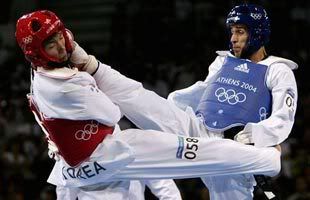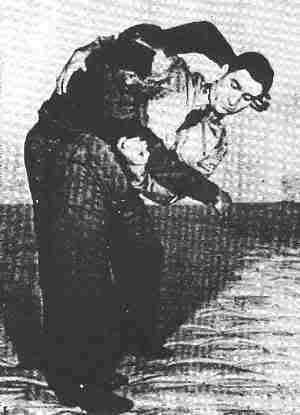
"Last night I’m perusing Half Price Books and come a across ChungI'm probably going to get in trouble for this with my TKD brethren (I hold a 3rd Dan in ITF, and a 2nd in WTF-style), but oh well! Many TKD practitioners may not know that:
Do Kwan: The Power of Taekwondo by Simpkins. The taekwondo that this book
presents IS traditional Chung Do Kwan as practiced in the late 40s and 50s.
After perusing the book and the internet it appears that there as still schools
out there that teach taekwondo like this. Comparing it to the style that I am
learning was very interesting. The first thing I noticed is a greater emphasis
on hand techiques. The second thing was the fact that there are far fewer kicks
and they are not as complex; same for the footowork. I’m pretty sure that the
forms (aka katas) presented in the book are slight variations on Shotokan
katas."
- The original Kwans (schools or styles) of Korean arts were heavily influenced by Japanese and Okinawan Karate. Korea was occupied for more than a generation (1910-1945) by Japan, and many (most?) of the Kwan founders were students of, or heavily influenced by the Japanese arts. In fact, early on, they used the same forms!

- As the post acknowledged, the TKD stances, punches, and even kicks were performed more or less the same as their Japanese/Okinawan counterparts.
- Obviously, the color-belt system is Japanese in origin (Judo), but has been adopted by almost everyone.
The point of all of this is not to denigrate the Korean arts, but to make another point:
At some point, everything changed. Why? Why did the stances get higher? Why did the emphasis on kicks change? Why was there an introduction of full-power contact sparring, as opposed to the no-contact type still emphasized in some styles?
The answer is that TKD (at least the Olympic/WTF variant), became a sport. Gone was the emphasis on the deep stances and punching, which didn't distinguish TKD from Karate, and in comes the "trembling shock" scoring and spectacular high kicks of TKD competition that eventually helped make it an Olympic sport.
What happens is that when a "martial" art becomes a sport, it loses something. TKD (WTF) is no longer the well-rounded, practical art that it once was. To see that, look to ITF or Tang Soo Do, which refused to jump on the TKD bandwagon. There you will still see the complex forms, deep stances, powerful punches, and low kicks.
 Something similar took place with Judo many years ago. At one point, Judo was considered lethal self-defense, and included many aspects that are only preserved in their kata today - striking, knife defense, and self-defense. After it became a sport, it lost much of its effectiveness because the practitioners (now tellingly called "players") specialized in what could help them win in competition, and only within those rules. Take a look at old articles or video of Judo, and you'll see something that looks similar to traditional Japanese Ju-Jitsu.
Something similar took place with Judo many years ago. At one point, Judo was considered lethal self-defense, and included many aspects that are only preserved in their kata today - striking, knife defense, and self-defense. After it became a sport, it lost much of its effectiveness because the practitioners (now tellingly called "players") specialized in what could help them win in competition, and only within those rules. Take a look at old articles or video of Judo, and you'll see something that looks similar to traditional Japanese Ju-Jitsu.
A final point is that all martial sports can be effective for self-defense, it just takes the determination of the practitioner to concentrate on that aspect.
See also:
The Martial Art vs Sport Debate
Why Are Martial Sports Superior?
Boxing for Self-Defense and MMA
What is the relationship of sport judo to unarmed combat?
Fighting in the Clinch
American Wrestling vs. Jujitsu
Training for Sport vs Training for Combat
If it's against the rules, then it must work!
Comments welcomed, threats discouraged!

2 comments:
Yeah, well...I'm already getting "feedback" from those two posts!
The main point I was making is in relation to learning how to strike effectively without hitting something solid. I'm literally astonished Shotokan does it this way and even more so with early historical taekwondo. I see a place for "no-contact" (i.e., our one steps) but question total reliance.
I also have to admit that my school is pretty broad-minded: Tradition, sport, and defense. We've even had a defense against ground fighting class and most of our accrediting body member schools teach boxing strikes from a tko perspective.
Anyhow, I really enjoy taekwondo and you are correct that even in a total sport school there are combat lessons. The catch is for the student to look for them or the instructor(s) to teach them.
Bob Patterson
I'm still not sure that it's not possible to be effective as a fighter training with no-contact sparring, I just need someone to explain how! As far as TKD, no offense intended, I've seem some amazing fighters who've come from that style, it just depends on the school and instructor. I've even produced a few of them myself. I like what you've said about your school - tradition, sport, and defense. Sport can give us the "reps" like few things can, it's just important to avoid the muscle memory of training only the sport...
Post a Comment